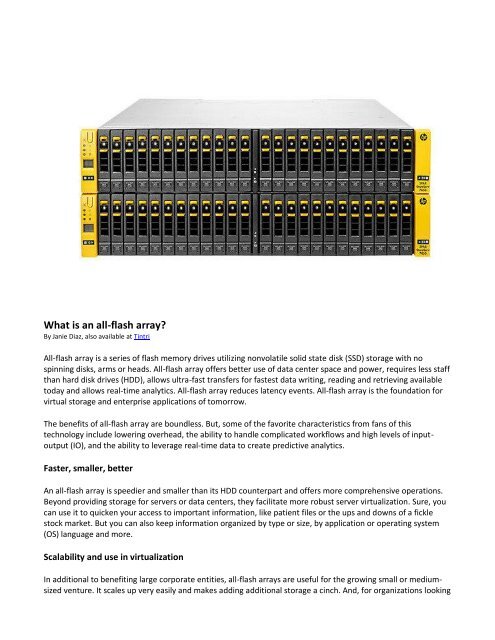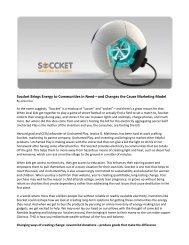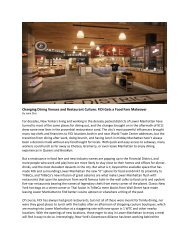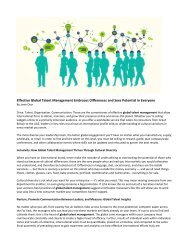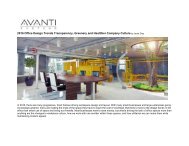What is an all-flash array
A description of the characteristics and details of the all-flash array and what it is capable of. Specs of AFAs, and how they do what they do within the modern data center.
A description of the characteristics and details of the all-flash array and what it is capable of. Specs of AFAs, and how they do what they do within the modern data center.
You also want an ePaper? Increase the reach of your titles
YUMPU automatically turns print PDFs into web optimized ePapers that Google loves.
<strong>What</strong> <strong>is</strong> <strong>an</strong> <strong>all</strong>-<strong>flash</strong> <strong>array</strong>?<br />
By J<strong>an</strong>ie Diaz, also available at Tintri<br />
All-<strong>flash</strong> <strong>array</strong> <strong>is</strong> a series of <strong>flash</strong> memory drives utilizing nonvolatile solid state d<strong>is</strong>k (SSD) storage with no<br />
spinning d<strong>is</strong>ks, arms or heads. All-<strong>flash</strong> <strong>array</strong> offers better use of data center space <strong>an</strong>d power, requires less staff<br />
th<strong>an</strong> hard d<strong>is</strong>k drives (HDD), <strong>all</strong>ows ultra-fast tr<strong>an</strong>sfers for fastest data writing, reading <strong>an</strong>d retrieving available<br />
today <strong>an</strong>d <strong>all</strong>ows real-time <strong>an</strong>alytics. All-<strong>flash</strong> <strong>array</strong> reduces latency events. All-<strong>flash</strong> <strong>array</strong> <strong>is</strong> the foundation for<br />
virtual storage <strong>an</strong>d enterpr<strong>is</strong>e applications of tomorrow.<br />
The benefits of <strong>all</strong>-<strong>flash</strong> <strong>array</strong> are boundless. But, some of the favorite character<strong>is</strong>tics from f<strong>an</strong>s of th<strong>is</strong><br />
technology include lowering overhead, the ability to h<strong>an</strong>dle complicated workflows <strong>an</strong>d high levels of inputoutput<br />
(IO), <strong>an</strong>d the ability to leverage real-time data to create predictive <strong>an</strong>alytics.<br />
Faster, sm<strong>all</strong>er, better<br />
An <strong>all</strong>-<strong>flash</strong> <strong>array</strong> <strong>is</strong> speedier <strong>an</strong>d sm<strong>all</strong>er th<strong>an</strong> its HDD counterpart <strong>an</strong>d offers more comprehensive operations.<br />
Beyond providing storage for servers or data centers, they facilitate more robust server virtualization. Sure, you<br />
c<strong>an</strong> use it to quicken your access to import<strong>an</strong>t information, like patient files or the ups <strong>an</strong>d downs of a fickle<br />
stock market. But you c<strong>an</strong> also keep information org<strong>an</strong>ized by type or size, by application or operating system<br />
(OS) l<strong>an</strong>guage <strong>an</strong>d more.<br />
Scalability <strong>an</strong>d use in virtualization<br />
In additional to benefiting large corporate entities, <strong>all</strong>-<strong>flash</strong> <strong>array</strong>s are useful for the growing sm<strong>all</strong> or mediumsized<br />
venture. It scales up very easily <strong>an</strong>d makes adding additional storage a cinch. And, for org<strong>an</strong>izations looking
toward a future with cloud for clients, <strong>all</strong>-<strong>flash</strong> <strong>array</strong>s with virtualization-aware capabilities are the only <strong>an</strong>swer.<br />
Those <strong>array</strong>s are geared toward housing the building blocks of cloud—virtual machines <strong>an</strong>d containers—without<br />
shuffling between LUNs <strong>an</strong>d volumes.<br />
Added benefits: no more worrying<br />
When you use <strong>all</strong>-<strong>flash</strong> <strong>array</strong>s <strong>an</strong>d the right user interface (UI), you don’t need to worry about storage<br />
capabilities, workload dem<strong>an</strong>ds or suddenly unsupported HDD <strong>array</strong>s. All-<strong>flash</strong> from Tintri solves these <strong>is</strong>sues<br />
with virtualization-aware storage (VAS). You won't need to bite your nails wondering about the software that<br />
runs your <strong>array</strong>s when you choose the Tintri Global Center (TGC) m<strong>an</strong>agement console.<br />
When you're operating cloud, you need <strong>all</strong>-<strong>flash</strong> <strong>array</strong>s <strong>an</strong>d VAS because the building block l<strong>an</strong>guage of the<br />
cloud <strong>is</strong> VMs <strong>an</strong>d containers, not LUNs <strong>an</strong>d volumes. To recognize the building blocks of cloud, you need a Web<br />
services architecture, which connects to compute <strong>an</strong>d network to apply automation policies <strong>an</strong>d share data.<br />
<strong>What</strong>’s next?<br />
VM <strong>is</strong>olation through individual l<strong>an</strong>es<br />
Prevent IO traffic jams by giving each VM its own l<strong>an</strong>e. Speed up processes, preserve perform<strong>an</strong>ce, <strong>an</strong>d never<br />
worry about the level of perform<strong>an</strong>ce you're getting from each individual VM. Select quality of service (QoS)<br />
settings for individual VMs as you w<strong>is</strong>h, <strong>an</strong>d enh<strong>an</strong>ce your over<strong>all</strong> system's agility <strong>an</strong>d speed even more.<br />
Multiple configurations for varied architectural needs<br />
If you're worried about having a flexible architecture capable of scaling out as your venture grows, you c<strong>an</strong> set<br />
that concern aside with the Tintri T5000 All-Flash Array, which <strong>is</strong> available in nine configurations. These<br />
architectures vary in capacity up to 308 TB, which uses groundbreaking 3D NAND, <strong>an</strong>d as m<strong>an</strong>y as 32 VMstores<br />
<strong>an</strong>d 160,000 VMs. All these VMs <strong>an</strong>d <strong>all</strong>-<strong>flash</strong> <strong>array</strong>s are easily m<strong>an</strong>aged from TGC—a single central console for<br />
m<strong>an</strong>aging your whole <strong>all</strong>-<strong>flash</strong> <strong>array</strong> <strong>an</strong>d <strong>all</strong> the VMs within your architecture.<br />
Greater automation through concurrent hyperv<strong>is</strong>ors<br />
A quality <strong>all</strong>-<strong>flash</strong> <strong>array</strong> <strong>an</strong>d VM m<strong>an</strong>agement system <strong>all</strong>ows your enterpr<strong>is</strong>e to run on the most gr<strong>an</strong>ular level<br />
possible. Using multiple concurrent hyperv<strong>is</strong>ors with deep integration for <strong>all</strong>-<strong>flash</strong> storage systems lowers<br />
overhead through superior automation.<br />
Know what's up with apps in real time<br />
Find out where lags ex<strong>is</strong>t with the click of a mouse. With real-time <strong>an</strong>alytics, you c<strong>an</strong> find where latencies ex<strong>is</strong>t<br />
on the VM level, which keeps you from losing time. That me<strong>an</strong>s you'll stay at the head of your class while<br />
competitors use delayed stat<strong>is</strong>tics <strong>an</strong>d outdated data. With Tintri, there’s no more wondering what just<br />
happened because you’ll have <strong>all</strong> the real-time data you need about every event that occurs in every VM,<br />
period.
Backup <strong>an</strong>d recovery in a snap<br />
With the click of a mouse, recover <strong>an</strong>d back up individual VMs. Say goodbye to spreadsheets <strong>an</strong>d conflicting,<br />
outdated information <strong>an</strong>d say hello to a simple user interface that <strong>all</strong>ows you tr<strong>an</strong>sfer VMs from one <strong>array</strong> to<br />
<strong>an</strong>other in no time flat.<br />
T5000 All-Flash Array <strong>an</strong>d the character<strong>is</strong>tics outlined above represent just one of m<strong>an</strong>y ways the world of data<br />
storage <strong>is</strong> ch<strong>an</strong>ging. There’s no denying these ch<strong>an</strong>ges are made possible only through the ex<strong>is</strong>tence of the <strong>all</strong><strong>flash</strong><br />
<strong>array</strong>, especi<strong>all</strong>y when combined with VAS. Being able to m<strong>an</strong>age your data, applications <strong>an</strong>d other<br />
information on the most gr<strong>an</strong>ular level possible <strong>is</strong> where the future of data centers <strong>an</strong>d storage <strong>is</strong> headed. All<strong>flash</strong><br />
<strong>array</strong>s are arguably the most import<strong>an</strong>t component for making th<strong>is</strong> future possible.<br />
The future of the <strong>all</strong>-<strong>flash</strong> <strong>array</strong> lies at the center of Tintri Cloud Enterpr<strong>is</strong>e. The Tintri T5000 <strong>all</strong>ows you to<br />
m<strong>an</strong>age information at the VM level while offering the agility of public cloud from your private data centers. The<br />
following five areas of m<strong>an</strong>agement available through Tintri are what separates the future of <strong>all</strong>-<strong>flash</strong> <strong>array</strong>s<br />
from its past.


